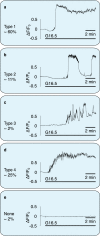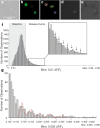Glucose and NAADP trigger elementary intracellular β-cell Ca2+ signals
- PMID: 34021189
- PMCID: PMC8140081
- DOI: 10.1038/s41598-021-88906-0
Glucose and NAADP trigger elementary intracellular β-cell Ca2+ signals
Abstract
Pancreatic β-cells release insulin upon a rise in blood glucose. The precise mechanisms of stimulus-secretion coupling, and its failure in Diabetes Mellitus Type 2, remain to be elucidated. The consensus model, as well as a class of currently prescribed anti-diabetic drugs, are based around the observation that glucose-evoked ATP production in β-cells leads to closure of cell membrane ATP-gated potassium (KATP) channels, plasma membrane depolarisation, Ca2+ influx, and finally the exocytosis of insulin granules. However, it has been demonstrated by the inactivation of this pathway using genetic and pharmacological means that closure of the KATP channel alone may not be sufficient to explain all β-cell responses to glucose elevation. We have previously proposed that NAADP-evoked Ca2+ release is an important step in stimulus-secretion coupling in pancreatic β-cells. Here we show using total internal reflection fluorescence (TIRF) microscopy that glucose as well as the Ca2+ mobilising messenger nicotinic acid adenine dinucleotide phosphate (NAADP), known to operate in β-cells, lead to highly localised elementary intracellular Ca2+ signals. These were found to be obscured by measurements of global Ca2+ signals and the action of powerful SERCA-based sequestration mechanisms at the endoplasmic reticulum (ER). Building on our previous work demonstrating that NAADP-evoked Ca2+ release is an important step in stimulus-secretion coupling in pancreatic β-cells, we provide here the first demonstration of elementary Ca2+ signals in response to NAADP, whose occurrence was previously suspected. Optical quantal analysis of these events reveals a unitary event amplitude equivalent to that of known elementary Ca2+ signalling events, inositol trisphosphate (IP3) receptor mediated blips, and ryanodine receptor mediated quarks. We propose that a mechanism based on these highly localised intracellular Ca2+ signalling events mediated by NAADP may initially operate in β-cells when they respond to elevations in blood glucose.
Conflict of interest statement
The authors declare no competing interests.
Figures




Similar articles
-
Nicotinic Acid Adenine Dinucleotide Phosphate (NAADP) and Endolysosomal Two-pore Channels Modulate Membrane Excitability and Stimulus-Secretion Coupling in Mouse Pancreatic β Cells.J Biol Chem. 2015 Aug 28;290(35):21376-92. doi: 10.1074/jbc.M115.671248. Epub 2015 Jul 7. J Biol Chem. 2015. PMID: 26152717 Free PMC article.
-
NAADP: a new second messenger for glucose-induced Ca2+ responses in clonal pancreatic beta cells.Curr Biol. 2003 Feb 4;13(3):247-51. doi: 10.1016/s0960-9822(03)00041-1. Curr Biol. 2003. PMID: 12573222
-
SIDT2 is involved in the NAADP-mediated release of calcium from insulin secretory granules.J Mol Endocrinol. 2016 Apr;56(3):249-59. doi: 10.1530/JME-15-0227. Epub 2016 Jan 7. J Mol Endocrinol. 2016. PMID: 26744456
-
Roles of cADPR and NAADP in pancreatic beta cell signaling.Cell Calcium. 2022 May;103:102562. doi: 10.1016/j.ceca.2022.102562. Epub 2022 Feb 16. Cell Calcium. 2022. PMID: 35219154 Review.
-
Physiological roles of NAADP-mediated Ca2+ signaling.Sci China Life Sci. 2011 Aug;54(8):725-32. doi: 10.1007/s11427-011-4207-5. Epub 2011 Jul 24. Sci China Life Sci. 2011. PMID: 21786195 Review.
Cited by
-
Two-pore channels: going with the flows.Biochem Soc Trans. 2022 Aug 31;50(4):1143-1155. doi: 10.1042/BST20220229. Biochem Soc Trans. 2022. PMID: 35959977 Free PMC article.
-
COVID-19: Are We Facing Secondary Pellagra Which Cannot Simply Be Cured by Vitamin B3?Int J Mol Sci. 2022 Apr 13;23(8):4309. doi: 10.3390/ijms23084309. Int J Mol Sci. 2022. PMID: 35457123 Free PMC article. Review.
-
RyR2 regulates store-operated Ca2+ entry, phospholipase C activity, and electrical excitability in the insulinoma cell line INS-1.PLoS One. 2023 May 4;18(5):e0285316. doi: 10.1371/journal.pone.0285316. eCollection 2023. PLoS One. 2023. PMID: 37141277 Free PMC article.
-
Solid phase extraction chromatography-based radiochemical isolation of cyclotron-produced 51Mn from enriched 54Fe targets.Nucl Med Biol. 2025 Mar-Apr;142-143:108989. doi: 10.1016/j.nucmedbio.2024.108989. Epub 2024 Dec 17. Nucl Med Biol. 2025. PMID: 39729887
-
Regulation of autophagy by perilysosomal calcium: a new player in β-cell lipotoxicity.Exp Mol Med. 2024 Feb;56(2):273-288. doi: 10.1038/s12276-024-01161-x. Epub 2024 Feb 1. Exp Mol Med. 2024. PMID: 38297165 Free PMC article. Review.
References
Publication types
MeSH terms
Substances
Grants and funding
LinkOut - more resources
Full Text Sources
Other Literature Sources
Miscellaneous

